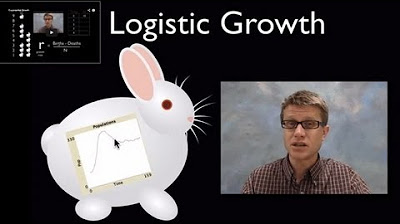r-selected and K-selected population growth strategies | High school biology | Khan Academy
Summary
TLDRThis video explains different population growth strategies of species, focusing on the distinction between K-selected and R-selected species. K-selected species, such as elephants and humans, are long-lived, have fewer offspring, and are limited by resources, while R-selected species, like frogs and insects, reproduce quickly with many offspring and are influenced by environmental factors. The video also highlights how invasive species tend to be more R-selected, and it briefly touches on the difference between population growth strategies and niche strategies, setting up for future discussions.
Takeaways
- 🐘 Species like elephants and killer whales are long-lived, similar to humans, and have slow reproduction rates.
- 👶 K-selected species, like large mammals, have few offspring at a time and invest significant care in their young.
- 🕷️ R-selected species, like frogs and insects, have short lifespans but produce many offspring in each reproductive event.
- 🌍 R-selected species often rely on environmental factors, like temperature and moisture, to determine their reproductive success.
- 📈 Population growth in R-selected species is typically exponential when resources are abundant, represented by the letter R in the growth equation.
- 📉 K-selected species reach a carrying capacity (K) where competition for resources limits their population growth.
- 🐢 Some species, like turtles, don't fit neatly into either category—they have traits from both R and K strategies.
- 🦠 Invasive species tend to be R-selected, growing rapidly and being less limited by competition within their own population.
- 🐅 K-selected species are often more vulnerable to invasive species due to their slower reproduction and population growth rates.
- 🌿 Population growth strategies (R and K) are separate from niche strategies, which involve how species utilize available resources.
Q & A
What is the main topic of the video?
-The video discusses different population growth strategies among species, focusing on two broad categorizations: K-selected and R-selected species.
What are examples of K-selected species mentioned in the video?
-Examples of K-selected species mentioned in the video include elephants, killer whales, humans, and gorillas.
What characteristics define K-selected species?
-K-selected species tend to be large, long-lived, produce few offspring per reproductive event, and invest significant time in raising their offspring. Their population growth is typically limited by resource availability.
What are R-selected species, and what examples were given?
-R-selected species are typically short-lived, small, and produce many offspring at once, such as frogs, spiders, mosquitoes, and bacteria.
How do R-selected species’ populations grow compared to K-selected species?
-R-selected species experience rapid, exponential population growth based on environmental factors like temperature and moisture, rather than being limited by competition for resources as in K-selected species.
Where do the terms 'R' and 'K' come from in population biology?
-'R' refers to the rate of population growth (biotic potential) in R-selected species, while 'K' represents the carrying capacity in K-selected species. The term 'K' is derived from a German word for capacity.
What happens to the population of K-selected species when resources become limited?
-When resources become limited, the population of K-selected species stabilizes at the carrying capacity, which is the maximum population size the environment can support.
Can all species be strictly categorized as K-selected or R-selected?
-No, the video mentions that nature is complex, and some species, like turtles, exhibit traits of both categories. Turtles, for example, lay many eggs like R-selected species but live long lives like K-selected species.
How do invasive species fit into the K vs. R selection framework?
-Invasive species are typically R-selected, meaning they reproduce rapidly and are limited more by environmental factors than by competition with other species, often outcompeting native K-selected species.
What is the difference between population growth strategies and niche strategies?
-Population growth strategies refer to how species grow in population (K-selected vs. R-selected), while niche strategies refer to how species occupy different ecological roles or niches in their environment.
Outlines

Cette section est réservée aux utilisateurs payants. Améliorez votre compte pour accéder à cette section.
Améliorer maintenantMindmap

Cette section est réservée aux utilisateurs payants. Améliorez votre compte pour accéder à cette section.
Améliorer maintenantKeywords

Cette section est réservée aux utilisateurs payants. Améliorez votre compte pour accéder à cette section.
Améliorer maintenantHighlights

Cette section est réservée aux utilisateurs payants. Améliorez votre compte pour accéder à cette section.
Améliorer maintenantTranscripts

Cette section est réservée aux utilisateurs payants. Améliorez votre compte pour accéder à cette section.
Améliorer maintenant5.0 / 5 (0 votes)






